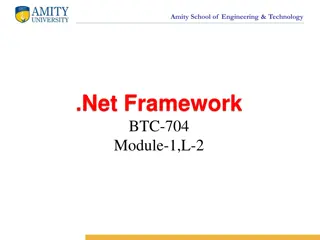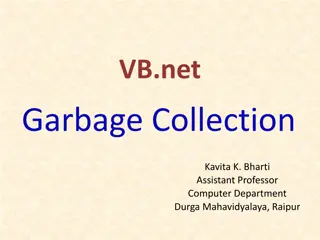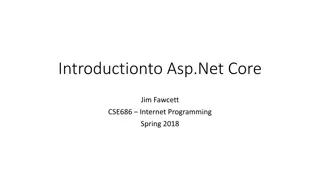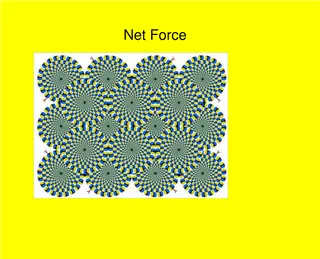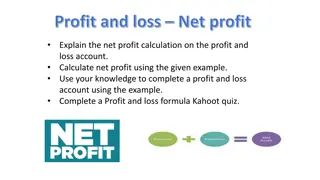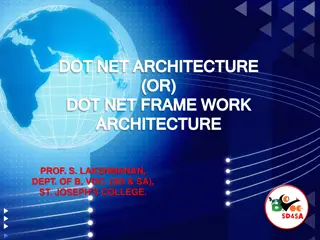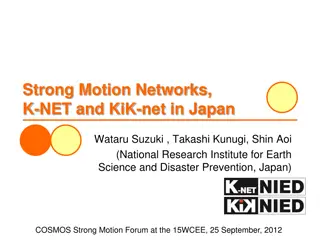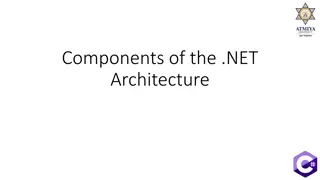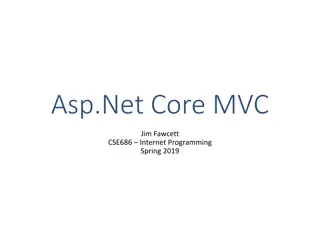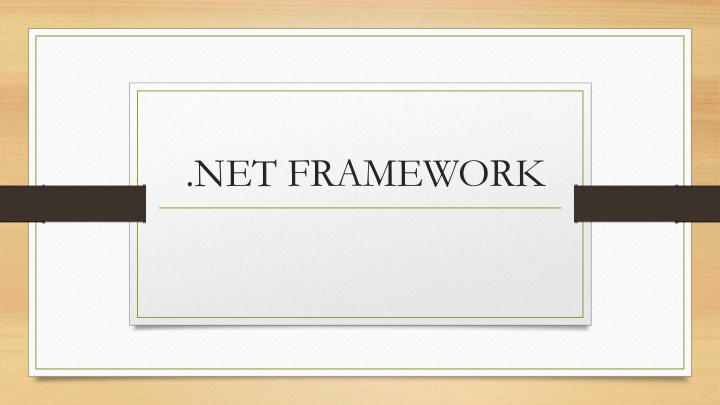
.NET Framework: A Comprehensive Overview
Learn about the .NET Framework, a powerful software framework by Microsoft that enables the development of web services. Explore its components, services, and the origins of .NET technology including OLE and COM Technology.
Download Presentation

Please find below an Image/Link to download the presentation.
The content on the website is provided AS IS for your information and personal use only. It may not be sold, licensed, or shared on other websites without obtaining consent from the author. If you encounter any issues during the download, it is possible that the publisher has removed the file from their server.
You are allowed to download the files provided on this website for personal or commercial use, subject to the condition that they are used lawfully. All files are the property of their respective owners.
The content on the website is provided AS IS for your information and personal use only. It may not be sold, licensed, or shared on other websites without obtaining consent from the author.
E N D
Presentation Transcript
.NET is a software framework that includes everything required for developing software for web services. It integrates presentation technologies,component technologies and data technologies on a single platform so as to enable users to develop internet applications. Microsoft took many of the best ideas in the industry ,added their own creativity and innovations and produced a coherent system solution known as Microsoft .NET.
.NET Strategy Microsoft .NET strategy Microsoft .NET Platform Microsoft .NET Product & Services Third Party .NET Services
.NET Platform Includes the following components that would help to develop a new generation of smart internet services. .NET infrastructure and tools. .NET user experience .NET building block. .NET device software
.NET Product & Services Windows.NET MSN.NET Office.NET Visual Studio .NET Personal Subscription Services bCentral for .NET
Third party .NET services will provide opportunity to a wide range of developers and users to produce corporate and vertical services using .NET platform.
OLE technology OLE (Object Linking and Embedding) technology was developed by Microsoft in the early 1990 to enable easy interprocess communications. OLE provided support to achieve the following. To embed documents from one application into another application. To enable one application to manipulate objects located in another application. Eg : between Word and Excel.
COM Technology In component based approach a program is broken into a number of independent components where each one offers a particular service. Each component can be developed and tested separately and integrated into the main system. This technology is known as Component Object Model (COM) and software built using COM is referred to as component ware. COM technology offers a number of benefits to the developers and users. Reduces overall complexity of software. Enables distributed environment across multiple organizations or departments. Enhances software maintainability.
.NET Technology .NET technology is a Third Generation Component Model. This provides a new level of interoperability compared to COM technology. COM provides a standard binary mechanism for intermodule communication. This is replaced by an intermediate language called Microsoft Intermediate Language(MSIL) or simply IL in .NET technology. An inherent characteristic of IL code is metadata. Metadata is data about data and describes its characteristics ,including data types and location. IL allows for true cross language integration. In addition to IL,.NET includes a host of other technologies and tools that will enable us to develop and implement Web based applications easily.
Various components of .NET platform .NET Platform .NET Building Block Services .NET Device Services .NET Infrastructure & Tools .NET User Experience
Visual Studio .NET .NET Experience Service .NET Framework Windows .NET
.NET Framework .NET framework provides an environment for building,deploying and running web services and other applications. It consists of three distinct technologies. Common Language Runtime (CLR) Framework Base Classes. User & Program Interfaces (ASP .NET & Winforms)
Common Language Runtime (CLR) .NET CLR is a run-time environment that manages and executes the code written in any .NET programming language. It converts code into native code which further can be executed by the CPU. It also supports cross-language interoperability. Functions It converts the program into native code. Handles Exceptions Provides type-safety Memory management Provides security Improved performance Language independent Platform independent Garbage collection Provides language features such as inheritance, interfaces, and overloading for object-oriented programmings.
Component structure of CLR Base Class Library Support It is a class library that provides support of classes to the .NET application. Thread Support It manages the parallel execution of the multi-threaded application. COM Marshaler It provides communication between the COM objects and the application. Type Checker It checks types used in the application and verifies that they match to the standards provided by the CLR. Code Manager It manages code at execution run-time. Garbage Collector It releases the unused memory and allocates it to a new application. Exception Handler It handles the exception at runtime to avoid application failure. ClassLoader It is used to load all classes at run time.
Flowchart of CLR activities for executing a program C# source code Compiler IL & Metadata Linker EXE Code Metadata Engine Other Native Code Basic Class Library Class Loader Verifier Test Output Native Machine code JIT Compiler Runtime Manager
Common Type System (CTS) It is a standard that specifies how type definitions and specific values of types are represented in computer memory. It is intended to allow programs written in different programming languages to easily share information. Common Language Specification(CLS) It defines a set of rules that enables interoperability on .NET platform. It is a subset of CTS and therefore the languages supporting CLS can use each others class libraries as if they are their own.
Microsoft Intermediate Language(MSIL) It is an instruction set into which all .NET programs are compiled. It is akin to assembly language and contains instructions for loading , storing, initializing and calling methods. When we compile a C# program or any program written in CLS language,the source code is compiled in MSIL.
Managed Code The code that satisfies the CLR at runtime inorder to execute is refered to as managed code. Compilers that are compatible to .NET platform generate managed code. Eg : C# compiler generates managed code.The managed code generated by C# is IL.The IL code is then converted to native machine code by JIT compliers.
Framework Base Classes .NET Framework Class Library is the collection of classes, namespaces, interfaces and value types that are used for .NET applications. We can use them by simply instantiating them and invoking their methods or by inheriting them through derived classes. Much of the functionality in the base framework classes resides in the vast namespace called System. It contains thousands of classes that supports the following functions. Base and user-defined data types Support for exceptions handling input/output and stream operations Communications with the underlying system Access to data Ability to create Windows-based GUI applications Ability to create web-client and server applications Support for creating web services
User & Program Interface .NET framework provides the following tools for manging user and application interfaces. Windows Forms Console Applications Web Forms Web Services These tools enable users to develop a user friendly desktop based as well as web based applications using a wide variety of languages on the .NET platform.
Visual Studio .NET It supports an Integrated Development Environment (IDE) with a rich set of features and productivity tools. These features and tools allow developers to build web applications faster and easier. We need not have to switch forth between environments to build , debug and deploy our code. VS.NET provides tools that extends support to the development lifecycle
Developing Lifecycle Planning Analysis Design Manage & Collaborate Development Testing Deployment Visual Studio .NET
.NET Languages Native to .NET C#(specially created for .NET) Visual Basic C++ Jscript Third Party Languages COBOL SmallTalk Eiffel Mercury Perl Scheme Python




